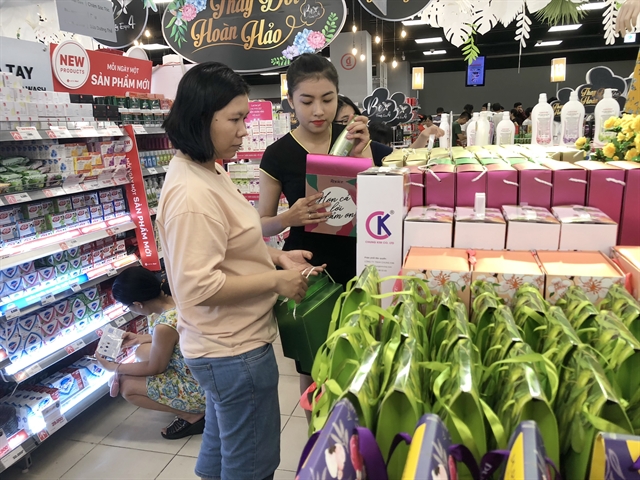 Economy
Economy

The personal care sector has enjoyed strong growth of 7 per cent a year on average, higher than the fast moving consumers goods (FMCG) market, thanks to the skincare and make-up segment, according to a study by global data and consulting company Kantar Worldpanel.

|
| Customers shop for cosmetics at a supermarket in HCM City. — VNS Photo Xuân Hương |
HCM CITY — The personal care sector has enjoyed strong growth of 7 per cent a year on average, higher than the fast moving consumers goods (FMCG) market, thanks to the skincare and make-up segment, according to a study by global data and consulting company Kantar Worldpanel.
Rapid economic growth and higher living standards are shaping changes in Vietnamese lifestyles and needs.
Urbanites now spend not only on basic products but also on aspirational demands.
Besides being able to afford advanced beauty products, Vietnamese women are not hesitant about paying more for premium products that are capable of bringing about significant skin improvements.
The cosmetic market has been offering a wide range of beauty products, welcoming new brands, new variants, and new formats every day, which effectively stimulates consumer spending.
Also, the current digital world has opened a new door for new players entering the market.
Health and beauty stores, including cosmetic stores and pharmacies, continue growing in importance thanks to the entry of new players like Pharmacity, Watsons and Hello Beauty.
This channel remains the key for beauty categories since shoppers can look for physical testing, professional advice and recommendations in real time.
Additionally, with digital transformation, these stores offer a "phygital" experience which brings together the best from online and brick-and-mortar stores.
Easy access to the internet, especially via mobile phones, enables Vietnamese consumers to keep abreast of beauty trends faster, research product information more easily and shop conveniently online.
Noticeably, 80 per cent of incremental spending on beauty products comes from online shopping, according to the latest Omnichannel report.
In order to bring an omnichannel shopping experience to consumers, a number of brands are starting to build their own retail formats such as websites, chains and, lately, subscription models.
The phenomenal growth in popularity of Korean culture is clear across multiple aspects of Vietnamese life from TV dramas, movies, music, and reality TV shows to cuisine, travel and beauty.
In cosmetics, South Korea ranked first among countries exporting to Việt Nam in 2018 with nearly a third of the market. Korean brands are consistently expanding as the fastest growing brands in terms of shopper base, predominantly in the make-up and mask segments.
Potential for growth
According to experts, there is enormous room for growth in many beauty categories, which are still underdeveloped.
The Kantar report said two out of five Vietnamese households have never bought beauty products. But following the global beauty trend, Vietnamese are more willing to stretch their budget for advanced beauty solutions such as skincare devices and beauty supplements.
The rising need for self-indulgence has led to a great opportunity for beauty care beyond facial care. Professional hair care products, hand and body care, nail styling are all emerging, and have great potential to attract spending in the years to come.
Trần Quang Thắng, director of the HCM City Institute of Economics and Management, said, “The middle class, who spend a lot on cosmetics, is set to grow to 33 million by 2020.”
This again points to huge potential for growth.
Nguyễn Văn Minh, deputy chairman of the Việt Nam Association of Essential Oils, Aromatherapy and Cosmetics, said many famous foreign cosmetic brands had entered by opening representative offices, companies and factories and through agents and distributors, including high-end brands like Esteé Lauder, Lancome, Shiseido, Fendi, Clairins, and L'Oreal.
Some local cosmetics brands such as Thorakao, Saigon Cosmetic, Lana, Biona, and Sao Thái Dương had also achieved a certain position in the market though they still held a small share. — VNS